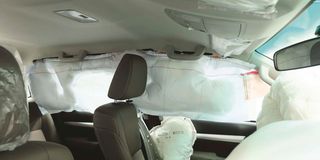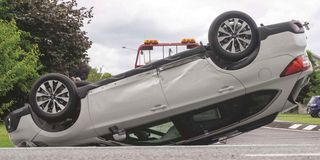Premium
How airbags work, and why you shouldn’t fiddle with them

In some markets, workshops that fit or check airbag pods require a firearms licence.
Can I retrofit airbags on an old car? Also, how safe is it to buy a used bag, and how can I check whether it is working properly? I would also like to know whether airbag systems can be repaired.
Charo
The realistic answer to retrofitting is No, unless you can somehow fit, with absolute precision, a complete modern dashboard designed to include airbags. The shape, height, angles and mountings of airbag pods are model-specific, and their mounting and exact positioning is very safety-critical.
Airbags are high tech with complex computerisation, and because it is life-and-death important that they unfailingly operate properly, every part of them is in a sealed pod, deliberately designed to deter any attempt at repair. If ever they are deployed or become faulty, they should be replaced.

Air bags. The presence of an airbag does not reduce the need to always buckle up.
There are used air bags on the world and local market (usually with iffy provenance) and they can be tested by electronic diagnosis. That job is not difficult for a specialist, but it needs to be done with care because air bags contain enough high explosives to deliver an “instant” air pressure of more than 1,000 psi (40 times higher than the pressure in your tyres, so 40 times what happens when a tyre has a blow-out). In some markets, workshops that fit or check air bag pods require a firearms license.
Detonation
Other than a power supply from the car’s electrical system, they do not have any external parts, such as trigger buttons on the front of the car. There is an electrical gadget inside them (an accelerometer) which constantly detects how rapidly a car is slowing down. If it reaches an extremely high threshold, that gadget will trigger detonation.
That threshold is pre-set in the pod’s own computer by the manufacturer (and there are specialised diagnostic gadgets that can read and reset the computer) usually at the calculated force that would be generated if a car drove head-in into a concrete wall at about 25kph. The presumption is that at lower speeds, the seatbelts would give occupants enough life-saving protection. And certainly the presence of an airbag does not reduce the need to always buckle up.

Crash test with 3d rendering dummy hit with air bag.
The forces generated by deceleration from 25kph or more to zero in the space of one meter (the front of the car would also crumple) is so enormously greater than severe braking or a mild traffic shunt that there should be no chance of a “marginal” deployment.
The risk of air bags in their designed position going off while you are doing other fix-it work under the dashboard is near zero, but it is not impossible, so be sure not to move them or abuse them in any way.
*****
Here are the different ways you can give your car a bit of a lift

Automotive shock absorbers and springs.
Gavin, my car is very comfortable on smooth roads and over small stones, but it leans on corners, bangs a lot on very rough roads, bounces a bit, and sometimes scrapes its belly on the top of speed bumps. Can I easily increase its ground clearance?
Carol
Those are classic indicators of a suspension that is too soft for local road conditions, and/or that either the shock absorbers or the springs or both are defective.
First check that the shock absorbers (and even the springs) are in good working order. If not, then replacing them will improve the ride stability and very slightly increase clearance. The replacements can also have a stiffer rating, but not too hard. The shock ratings must remain compatible with the spring ratings.
If they are too far out of sync with each other, then either the shocks will not be strong enough and the springs will be able to “bounce” the wheels, or the springs will not be strong enough and the shocks will fail prematurely as they compensate beyond their design limits.
If you want a very much harder setting, you will have to change both ratings.
The simplest way to increase clearance is to fit a slightly higher profile tyre with a bigger external diameter that will slightly raise the ride height (clearance) of the car. Again, the change cannot be too dramatic or there might not be enough room in the wheel arches for the bigger tyre. Also, a change in tyre diameter will slightly change the car’s gearing and cause a similar degree (perhaps 5 percent) of misread on your speedometer and odometer.
Clearance can also be increased by adjusting or changing the springs. The complexity and cost will depend on what type of springs your car has – generally coil springs, torsion bar springs or leaf springs.
The easiest to crank up are torsion bars. That can be done with a jack and a spanner. Coil springs need a spacer between the car body and their top mountings (or a longer replacement spring). Leaf springs can be fitted with longer shackles and/or have additional leaves. Your garage will know immediately, and give you advice on these various options.
Bear in mind a big change in the ride height can change the steering geometry and require adjustment to related components.
The better news is that small change will not cause that complication, and as the ground clearance of normal cars is not very large in the first place, a small increase can make a significant difference and might be all you need.
****
A crash course on road accident statistics

A car lies upside down after an accident.
Last week, you quoted the National Transport Safety Authority as saying defective parts are a contributory cause in only five per cent of accidents. What causes the other 95 per cent and what is the biggest culprit?
Isaiah
Short answer: The absolute champion cause, in one way or another, is “Human Error”. By the driver, a passenger, a pedestrian or cyclist, a shepherd, a road designer or town planner, a road builder, an administrator, a mechanic…
The steps pre-requisite to any policy commitment to inspection, or any rational public consultation or systems design include:
Full analysis and presentation, based on robust evidence and statistics (where data is unavailable or unreliable, compelling ratiocination should be demonstrated), of:
1. Research and data
The rigour and credentials of data being used to justify or guide the design of a mandatory inspection system (what data is collected, by whom, and the qualifications/experience of those gathering and processing the inputs) including any gaps or shortcomings and steps being taken to remedy them.
2. List all the root causes of road accidents
Driving standards and conduct, road design and condition, traffic patterns, vehicle roadworthiness, other road users, times and locations, other circumstances, for instance weather. Proportion of accidents primarily caused by, as opposed to merely involving, a motor vehicle.
3. Cause and Consequence factors
Any pattern between types of cause and the severity of consequences. Related “cause” factors (like driving tuition and testing) and related “consequence” factors (such as quality of emergency medical response).
4. Prioritisation for action
Which of the root causes/common denominators lead to the greatest number of the most severe accidents and therefore warrant highest priority for policy attention and resource investment. NTSA’s own figures assert that 95 percent of fatal accidents are NOT caused by defects or failure of mechanical components. Let us have a league table of all the other causes.
5. Review
Why existing legislation, policy and action has not effectively addressed these issues, and challenge previous policy and process assumptions which have been acted on without significant or sufficient remedial effect. Is that measured, by whom, and how?
6. Policy commitment
To address prime causes in what order of priority, with reasoning, and with timelines and resources apportioned accordingly.
7. Accountability for strategy
The order of priority, the resources assigned, and the impacts intended should be robustly justified as being in the public interest, as respecting balances of rights and responsibilities, and with mechanisms to assure accountability of the regulators and administrators and operators and infrastructural/enabling suppliers is not in any way less than the accountability of those who will be regulated, time-and-cost penalised and potentially punished for noncompliance.
On just those seven fundamentals, logic and colloquial evidence would suggest that numerous other causes and remedial imperatives would come before “vehicle defects” as a priority issue. And if, for any reason, attention to defects were judged to be a priority (before or in parallel with other measures), a further set of essential prerequisites would arise:
8. List all defects to which accidents have been attributed
What type of faults, on which specific components, have been recorded as prime causes of fatal accidents.
9. Particular defects which are statistically most dangerous
If accident analysis has been rigorous and accurate, specific catastrophic failures will stand out as more prevalent than others and/or most likely to cause serious accidents.
10. The likely causes of those particular defects
Damage by bad roads or bad driving, lack of service maintenance, poor workmanship on replacement, repair or adjustment, sub-standard parts, excessive wear/mileage/age in their respective proportions.
11. Reasons why vehicle owners have not remedied defects
•Lack of knowledge
•Lack time or awareness of importance.
•Affordability.
•Non-availability of parts or workshop skills.
•Indifference
•Policies already exist to address these problems.
12. Action to prevent defects
•Already taken (with what result?).
•Planned (with resource allocation, timing and target outcome).
•Target benchmarks against which effect can be measured.
13. Impact of inspection
Which of the causes of defects will annual inspection “prevent” with long-term assurance, and how? On which causes will inspection have time limited or no effect? Extrapolation of this impact on cause to overall impact on accident prevention (i.e if inspection prevents 5 percent of the causes of defects, and defects cause 5 percent of fatal accidents, inspection will reduce fatal accidents by 0.25 percent overall). Assessment of cost versus this result. Assessment of alternative deployment of that cost, and potential result (opportunity cost).
14. Inspection Capacity
•Number of vehicles in Kenya subject to inspection.
•Ratio of serious accidents comparing inspected and uninspected vehicles.
•Number of inspections that will need to be conducted annually, and proportions expected to pass/fail.
•Time taken to conduct each inspection/re-inspection.
•Logistics of test-driving.
•Transition of test fail to repair and retest (time, movement)
•Number of mechanics and facilities necessary to process per day, and subtracting them from what other current task?
•Availability and qualifications/experience of that number of mechanics.
•Number, size, location and cost of inspection centres.
•Equipment required per facility.
15 Standards. This is just a sample, there are hundreds more
•Scope of checks.
•Efficacy of testing methods.
•Balance of viable time and meaningful thoroughness.
•Emission test benchmarks.
•Any grading of degrees of pass/alert/fail.
•Any distinction in consequences.
•Grounds for appeal against remedial measures.
•Proportion of Kenya’s vehicle park likely to be temporarily or permanently disqualified.
Answers to all these questions (and potentially more), should be established and openly and widely published (open access website) well before meaningful public consultation can take place, or policy commitment can be justified, or system design can be assessed.
The very, very good practice of mandatory stakeholder consultation on public policy matters must ensure that stakeholders are fully informed. If transparency and accountability are separated, neither will have any meaning.





